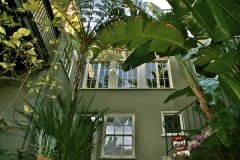Gallery |
|
Samuel Clemens, under the pen name Mark Twain, composed a series of monthly letters in 1866 chronicling his travels in the Pacific and the American West for the Sacramento Daily Union. In one of these letters (October 25, 1866) he described his discovery of the cheremoya, a semitropical plant said to originate in the mysterious Andes. Clemens wrote enthusiastically that it was “the most delicious fruit known to man.” Though an example of Twain’s literary hyperbole, this plant was a popular cash crop in Southern California by the 1890s. In 1923 young architect Paul Revere Williams designed a home to be built on a quiet cul-de-sac off Cheremoya Avenue, the former site of a cheremoya farm.
Cheremoya Avenue is now described as part of the old Hollywoodland tract or the Beachwood Canyon area, but was originally owned by O.E. Roberts. Roberts was a farmer known for providing grocers with top quality produce and unusual tropical fruits from his truck garden. He sold his property to developers in 1905. The buyers named an avenue in recognition of the exotic fruit Roberts cultivated. (Los Angeles Times, February 4, 1905) In 1923, Williams designed a home for a local grocer, Samuel J. Douds, to be built on this street.
Douds and his wife Lillian emigrated from Ireland to the United States in 1904. By 1923 Douds owned a thriving grocery at 1850 N. Vermont Avenue in Los Angeles. He contracted with Williams to design a family residence to represent his social and commercial success. Sited on a gentle slope with views of the Hollywoodland sign, the one-story, six-room, Spanish villa-style home cost $5,100 to build (original building permit).
By 1928 the Douds’ residence was surrounded by new construction in this rising Los Angeles suburb as seen in a vintage photo (image 5 — the white concrete house with flat roof is second from the left). The detached garage seen in the photo represented an important Southern California status symbol of the 1920s, an automobile.
In time the Douds home passed from the original owner and would change hands several times during the next 60 years. In 1958 Harold Leroy Clark, one of the first African Americans to move on the street, purchased the house. His move was not without incident. On September 16 an unhappy neighbor threw a piece of concrete through a bedroom window "after warning that Negroes were not wanted in the neighborhood." (Los Angeles Times, September 25, 1958) The incident was symbolic of the racial and social tensions in Los Angeles during the 1950s as successful African Americans moved into previously restricted residential areas.
Special thanks to Margaret McCarley, a Douds family descendent, for additional information.







